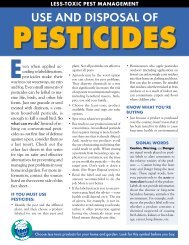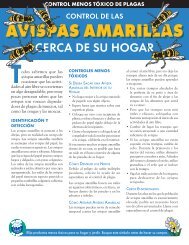Pesticides and Water Pollution - Our Water Our World
Pesticides and Water Pollution - Our Water Our World
Pesticides and Water Pollution - Our Water Our World
- No tags were found...
Create successful ePaper yourself
Turn your PDF publications into a flip-book with our unique Google optimized e-Paper software.
Less-Toxic Pest ManagementpesticidesAND water pollutionCommonly used pesticidescan be harmful topeople, pets, <strong>and</strong> the environment.Part of the problemis the toxicity of some pesticides,but even more important is thesheer volume of pesticides usedin this country every year. Muchof it finds its way to our water,air, <strong>and</strong> soil. Studies show thatthe most commonly used pesticidesare the ones most likelyto cause water pollution.Who applies all these chemicals?You might think that farmers aremainly responsible for pesticideproblems, but more than half ofCalifornia pesticide use is in urbanareas — by residents, homegardeners, <strong>and</strong> pest control professionalsin <strong>and</strong> around schools,businesses, <strong>and</strong> homes.The <strong>Our</strong> <strong>Water</strong>, <strong>Our</strong> <strong>World</strong> programwas developed in 1997 by clean wateragencies in response to pollutionproblems caused by two of the mostcommonly used residential pesticidesat that time — chlorpyrifos (Dursban)<strong>and</strong> diazinon. Both stormwater runoff<strong>and</strong> wastewater treatment plant dischargescontained levels of these twopesticides that were high enough tokill aquatic organisms at the bottomof the food web. In fact, in1998 theU.S. Environmental Protection Agency(EPA) listed 85 California waterbodiesas “impaired” due to diazinon.And in 2000, because of growing concernsabout the effects these chemicalshave on human health, EPA announcedan agreement with pesticide manufacturersto remove most products containingchlorpyrifos <strong>and</strong> diazinon from retailstore shelves <strong>and</strong> to end most residential<strong>and</strong> professional uses by the end of2004. Generally, since January 2005professionals have virtually stopped usingthese two pesticides in residentialareas. In spite of sales of these productsbeing discontinued, residents may stillbe using old supplies — potentially causingthe same problems that led to theirremoval from the market.<strong>Water</strong> quality agencies urge the publicnot to use pesticides that contain chlorpyrifos(Dursban) or diazinon. Instead,dispose of them at a householdhazardous waste facility (see below).NEW THREATS TO WATERQUALITYChemical pesticides designed to replacethese banned pesticides are available,but substituting another toxic chemicalwon’t help the environment. With thephase-out of diazinon <strong>and</strong> chlorpyrifos,pesticide products have either beenreplaced or reformulated using otherchemicals (referred to as “active ingredients”),including:• Pyrethroids: Many diazinon <strong>and</strong>chlorpyrifos products have beenreplaced with formulations usingpyrethroids. As a result, the use ofsynthetic pyrethroids in pesticideproducts has nearly tripled in just thelast few years. Pyrethroids are used inhundreds of products including pesticidesused outdoors on lawns or forspraying the perimeters of houses.Pyrethroids are broad-spectrum,long-lived synthetic chemicals thatinterfere with the function of thenervous system. Designed to kill awide variety of insect pests, (such asants, cockroaches, <strong>and</strong> lawn grubs)they are also highly toxic to fish,aquatic insects, crustaceans, <strong>and</strong> thebeneficial insects (such as ladybugs,lacewings, <strong>and</strong> earthworms), thatkeep pest populations under controlnaturally. Beneficial insects are oftenfar more sensitive to pesticides thanthe pests you might be trying tokill. Once pesticides eliminate thebeneficial insects, pests are free tomultiply without a natural check.Products containing pyrethroids haveingredient names typically endingin “-thrin,” including: permethrin,bifenthrin, cyfluthrin (including betacyfluthrin),cypermethrin,deltamethrin, lambda-Choose less toxic products for your home <strong>and</strong> garden. Look for this symbol before you buy.
cyhalothrin, <strong>and</strong> tralomethrin (oneexception is esfenvalerate). The pyrethroidsresmethrin <strong>and</strong> tetramethrinare used less widely outdoors so arenot as big a threat to water quality;however, they are present in aerosolproducts, which disperse chemicals ina way that significantly increases therisk of exposure to unintentional targets— including people <strong>and</strong> pets.• Malathion <strong>and</strong> Carbaryl (Sevin):Although these pesticides have beenavailable for many years, with thediscontinuation of diazinon, theiruse has increased. These chemicals,twice as toxic in salt water as infresh water, are already detectedfrequently in urban <strong>and</strong> suburbanwaterways across the country. Theyare also water soluble — meaningrain <strong>and</strong> over-watering can easilycause them to wash off lawns <strong>and</strong>gardens <strong>and</strong> enter storm drains <strong>and</strong>local waterways.Pyrethrins vs. PyrethroidsUnlike long-lived synthetic pyrethroids,natural pyrethrins are short-lived pesticidesmade from chrysanthemumflowers. Though natural pyrethrinsare less persistent in the environmentthan the synthetic pyrethroids, they arestill toxic to birds, fish, <strong>and</strong> beneficialinsects until they break down after afew hours in sunlight. Take steps toprevent pyrethrins from running off toa street, gutter, or storm drain.What Should You Doif You Have UnwantedPesticide ProductsAround the House?If you have unwanted or leftover pesticides,do not pour them in ANY draininside or outside your house. Do notput pesticides in the trash. Instead,take them to a household hazardouswaste collection facility or event. Call1-800-CLEANUP or visit www.ourwaterourworld.org/disposal_info.cfmfortimes <strong>and</strong> locations in your community.Empty five-gallon or smaller containerswith no free-flowing liquid may be putin the trash.How Can You BothManage Pests <strong>and</strong> HelpProtect the Health ofPeople, Pets, <strong>and</strong> <strong>Our</strong>Environment?• Follow the suggestions for less-toxicpest control <strong>and</strong> pest prevention inthe <strong>Our</strong> <strong>Water</strong>, <strong>Our</strong> <strong>World</strong> fact sheetseries that can be found online atwww.ourwaterourworld.org <strong>and</strong> inparticipating stores.• Another source of information onpest control alternatives is the Universityof California Statewide IPMProgram at http://ucipm.ucdavis.edu.• Try to keep your garden healthy <strong>and</strong>your home pest-free without resortingto chemical pesticides. Rememberthat when you apply pesticides,you are treating the symptom, ratherthan the cause of pest problems.Physical barriers (window screens<strong>and</strong> caulking to keep pests out),biological controls (introducingbeneficial insects), <strong>and</strong> culturalcontrols (keeping a clean house <strong>and</strong>a healthy garden that attracts beneficialinsects) are always preferableto chemical pesticides. In situationswhere a pesticide is necessary, however,the best products for the environmentare less toxic, less persistent,<strong>and</strong> more targeted on pests <strong>and</strong> not onbeneficial insects <strong>and</strong> plants.• Avoid wearing insect-repellent clothing.EPA recently found that wearingclothing treated with permethrin (asynthetic pyrethroid) more than oncea year could increase cancer risks.<strong>Pesticides</strong> <strong>and</strong><strong>Water</strong> <strong>Pollution</strong>Common household pesticides show up intreated wastewater <strong>and</strong> in local waterways,sometimes at levels that can harm sensitiveaquatic life. So, water pollution preventionagencies have teamed up with participatingretail stores, pesticide distributors, <strong>and</strong>manufacturers to reduce the risks associatedwith pesticide use. This fact sheet is part of aseries of fact sheets <strong>and</strong> store displays aimedat educating residents about less-toxic pestmanagement. For the rest of the series offact sheets, visit www.ourwaterourworld.org.Also, look for the “<strong>Our</strong> <strong>Water</strong> <strong>Our</strong> <strong>World</strong>”logo next to products in participating stores<strong>and</strong> nurseries. See the <strong>Pesticides</strong> <strong>and</strong> <strong>Water</strong><strong>Pollution</strong> fact sheet for information on activeingredients in common pesticides that maycause water quality problems.Pest control strategies <strong>and</strong> methods describedin this publication are consistent with integratedpest management (IPM) concepts, <strong>and</strong>are based on scientific studies <strong>and</strong> tests in actualhome <strong>and</strong> garden settings. Use suggestedproducts according to label directions <strong>and</strong>dispose of unwanted or leftover pesticidesat a household hazardous waste collectionfacility or event. For more information onpesticide disposal, call 1-800-CLEANUPor visit: www.1800CLEANUP.org. No endorsementof specific br<strong>and</strong> name productsis intended, nor is criticism implied of similarproducts that are not mentioned.ACKNOWLEDGMENTThe Central Contra Costa Sanitary Districtoriginally developed this IPM outreachprogram.FOR MORE INFORMATIONFor more information, contact:Bio-Integral Resource Center (BIRC)(510) 524-2567; www.birc.orgUniversity of California CooperativeExtension Master Gardeners in your area(in the phone book )University of California IPM websitewww.ipm.ucdavis.eduwww.<strong>Our</strong><strong>Water</strong><strong>Our</strong><strong>World</strong>.orgNovember 2008Paper content: 25% post-consumer waste, 50%recycled content. Printed with soy-based ink.





